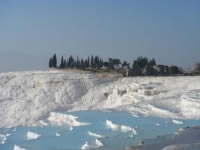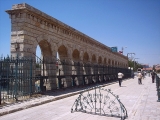Konya City Guide
Konya, one of the first
settlement places in human history has a background history of ordinary
settlement since prehistoric age and ruled under the dominance of
Hittites , Phrygia, Lydia, Persians, Bergama / Pergamos and Byzantines
one after another. The city was ruled by Seljuks in 1071 and was the
capital city of Anatolia Seljuks Empire from 1097 to 1277. It was under
the dominance of Ottoman Empire after rules by Karamanoglu Dynasty.
Being
one of the most important recreation and commerce stop of historical
Ancient Silk Road and being considered as an "open-air museum" Konya is
an important Anatolian City of Turkey. A big part of the city is
located in Central Anatolia Turkey and the rest part of the city is
located in Mediterranean Region of the Turkey.
This popular
Anatolian City has an important place of growing religious scholars and
scientist of the history and has a great rich history, culture and
natural beauties.
There
are numerous festivals and activities being held in Konya, and some of
the important ones are; Remembering Mevlana Festival being performed
in city center in December, International Nasreddin Hodja Festival
between July 5 and July 10 every year and Yunus Emre Art and Culture
Festival being held in Doganhisar Town every year the 4.Th week of
August.
Places to visit in Konya
Museums;
Museum of Mevlana which is the most important museum of Konya Dervish
Lodge of Mevlana covering an area of 1800 m2, Archeological Museum,
Ceramics Art Museum, Monuments Museum, Ethnography Museum, Aksehir,
House of Ataturk, Eregli Museums, Karatay Museum was established in
1251 and is displaying fine arts and ceramics from Ottoman Empire Era
nd Seljuks Age, Ince Minare Museum was built in 1254 and having a great
range of Seljuks Age's valueable stones and wooden artifacts to display
to it's visitors, Sircali Tomb Monuments Museum was constructed in
1242 and having a variety of Ottoman Empire's and Seljuk's Tomb Stones
to display, Koyunoglu , Aksehir Archeology and Aksehir Ataturk Museums.
Ruins and antique cities; Konya Ethnography Museum, Catalhoyuk where
you will see the first settlement, first architecture of a house and
first sacred / holly places was built in human life, Klistra Antique
city where one of the 12 disciples of Jesus gave a sermon for the first
time and is located on King's road, St. Helen Church was constructed in
327 A.C. and the preach chair and the colorful figures on the wall are
eye catching.
Historical mosques and religious buildings; Alaaddin Mosque (is an
example of 12. century Anatolian Seljuks Architecture and is one of the
oldest and biggest mosques of Konya. Minbar of this mosque is decorated
with gorgeous wood embroidery and Mihbar is decorated with ceramic
handcrafts.), Iplikci Mosque (was constructed in 13. century, and was
re-open in 1967), Sahip Ata , Sadrettin Konevi (who is one of the
scholars who used to live in 12.Th century), Sems-i Tebrizi , Kadi
Mursel, Tursunoglu / Tahir Pasa, Selimiye Mosque (is one of the best
example and arts of 16.Th century Ottoman Architectures), Azize,
Serafettin, Kapi, Nakipoglu, Pri Mehmet Pasa, Haci Fettah, Ovali Oglu,
Saray, Sep Hevan, Koprubasi, Namik Pasa and Amber Reis Mosques are only
some of the important historical religious arts and mosques in the area.
Tombs; Tombs of Sultans (was built by Sultan Kilincaslan , There are 8
sarcophagus in tomb belonging to; Sultan Mesud I, Kilincaslan II,
Rukneddin Suleyman II, Giyaseddin Keyhusrev I, Aleaddin Keykubat I,
Kilinaslan IV and Giyaseddin Keyhusrev III), Tavusbaba Tomb is belong
to Seyh Tavus Mehmet El Hindi, Ates-Baz Veli Tomb, Gomec Hatun Tomb the
wife of Anatolia Seljuk's Sultan Rukneddin Kilic Aslan VI, Kesikbas ,
Tahir and Zuhre, Emir Nurettin, Tac-ul Vezir, Burhaneddin Fakih Tomb
was build for scholar and Sufi Burhaneddin in 1454, Guhertas,
Karasungur, Pir Esat, Ulas Baba, Seyh Osman Rumi, Fakih Dede, Kalender
Baba, Siyavus Veli and Turgutogullari Tombs.
Monuments; Eflatunpinar is a sacred / holy Hittites Monument, Fasillar
Monuments is one of the biggest rock monuments of the world,
Eflatunpinar Hittites monuments and Ivriz embroidery.
Pavilions
and houses; Zazadin House was constructed by the Vezir of Seljuks
Sadettin Kopek , Horozlu Pavilion was established in 1248 in a shape of
caravansary without a backyard, Kizilviran House and Obluk Pavilion.
Thermals and spas; Ilgin Thermal Tourism Center, Kosk Spas and Ismail Thermal Spa.
Recreation
Areas; Meke Crater Lake and Aci Lake and many other crater lakes and
waterfalls such as Cirak Lake, Meyil Lake and Yerkopru Waterfalls.
Caves; There are 65 caves in Konya and we can list them mainly; Buyuk
Duden Cave in Derebucak, Tinaztepe Cave System in Saydisehir Town, Cave
of Balatini in Beysehir, Korukini Cave in Beysehir, Suluin /
Degirmenini Cave, Susuz Cave and Pinarbasi Cave.
Provinces of Konya
Ahirli, Yalihoyuk, Akoren, Tuzlukcu, Altinekil,
Taskent,Bozkir, Seydisehir, Cihanbeyli, Selcuklu, Celtik, Sarayonu,
Cumra, Meram, Derbent, Kulu, Derebucak, Karatay, Doganhisar, Huyuk,
Emirgazi, Hadim, Guneysinir and eregli.

 Pamukkale is one of the highlights of Turkey, and also referrers to Cotton castle in Turki.
Pamukkale is one of the highlights of Turkey, and also referrers to Cotton castle in Turki.  Istanbul city airports, location direction and maps of the all airports in Istanbul. How m.
Istanbul city airports, location direction and maps of the all airports in Istanbul. How m.  Zonguldak on the western part of Black Sea Region is a rich land for the history and ancie.
Zonguldak on the western part of Black Sea Region is a rich land for the history and ancie. 







Latest 5 Comments & Request: